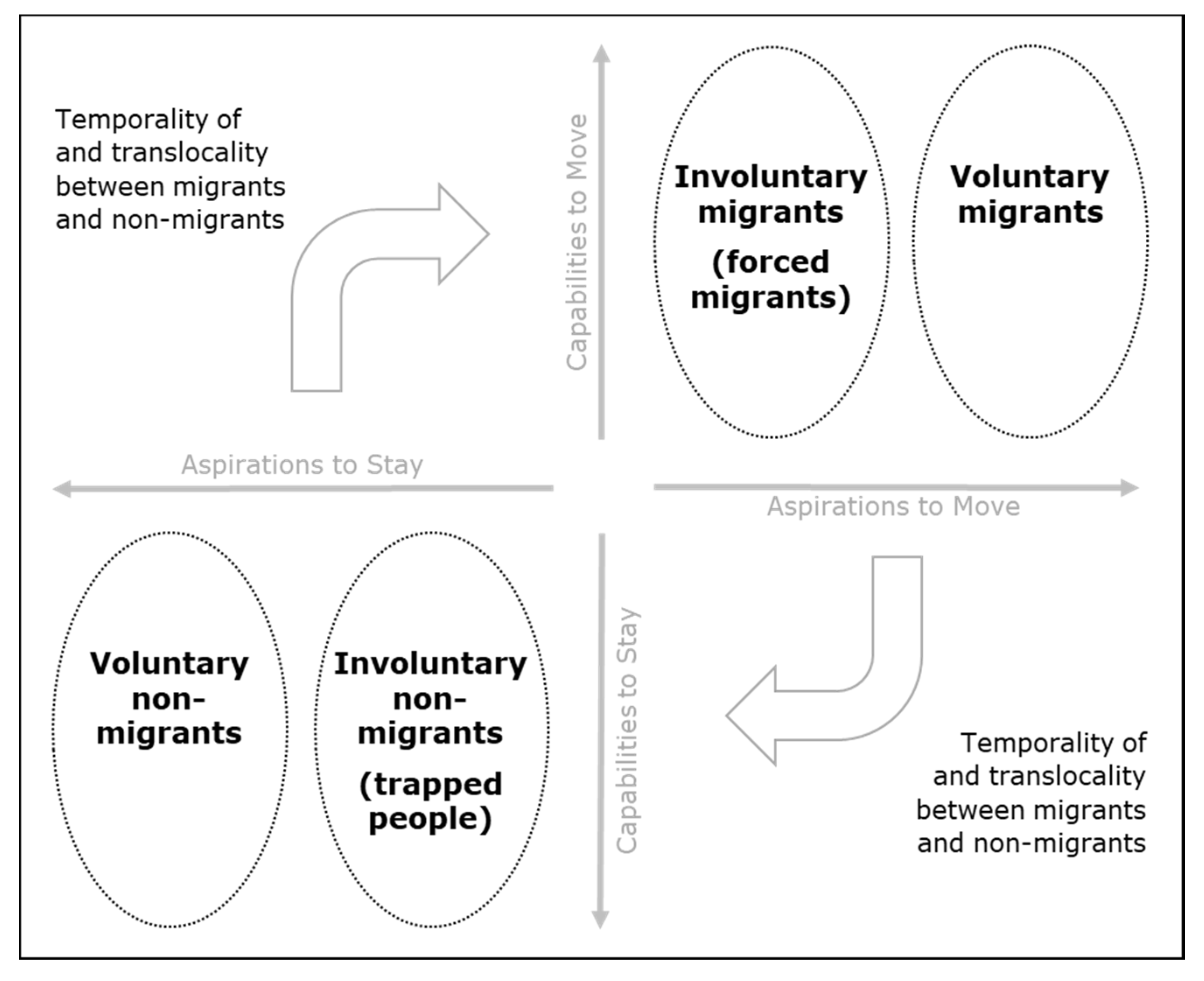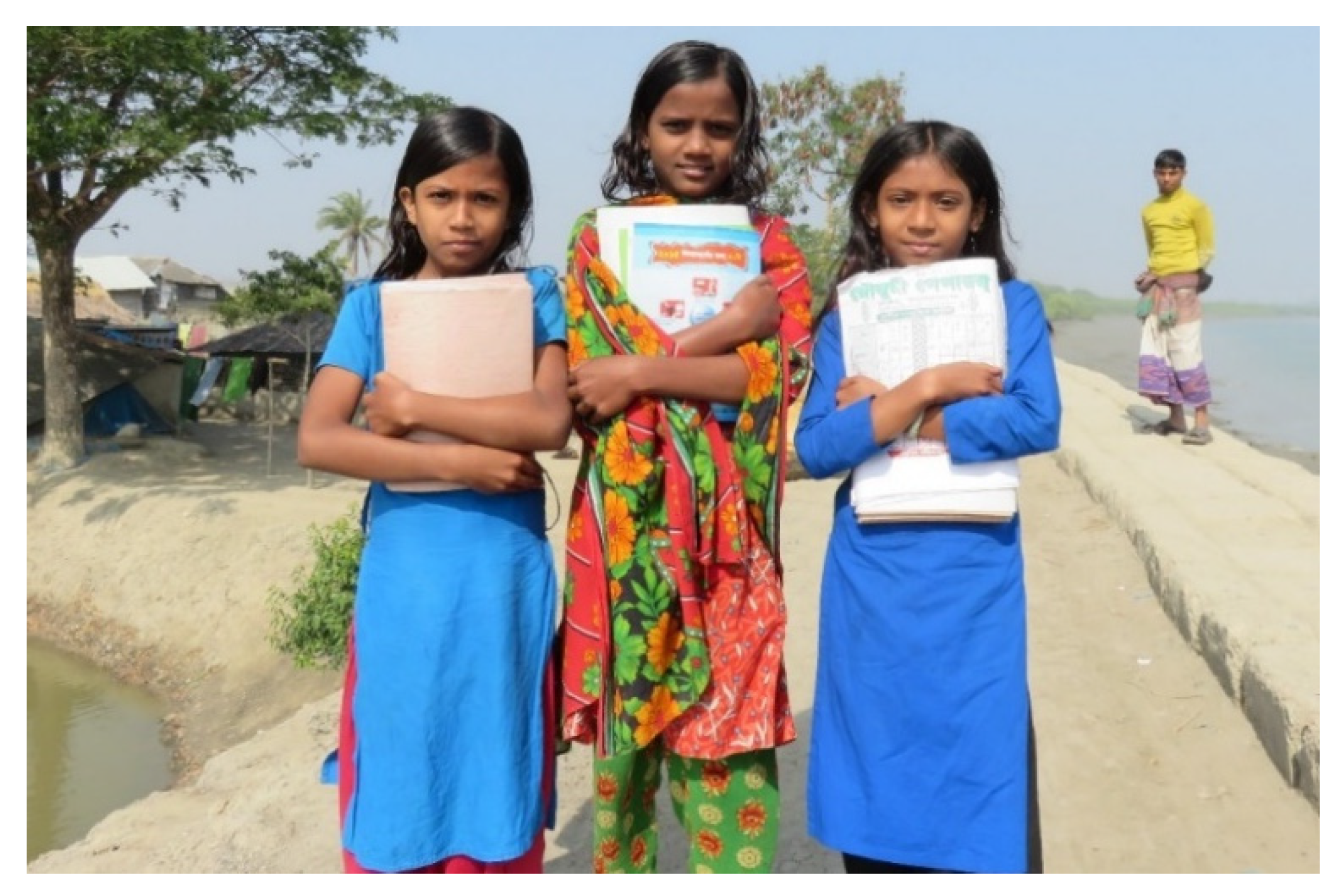1. Introduction
“… I would like to die at my birthplace. You know, when I smell the mud of my home …”
(Rokon Morol, 35 years old fisherman on 18 April 2016, Gabura village, Bangladesh)
Climate-induced displacement has become a reality around the world. The World Bank has estimated that 143 million people may be ‘climate migrants’ by 2050 [
1]. So far, most people that face climate risks do not migrate; for example, between 2008 and 2016, approximately 85% of those threatened by natural disasters did not relocate, according to data from the International Organization for Migration (IOM) [
2] and the Centre for Research on the Epidemiology of Disasters (CRED) [
3]. Some of these individuals may be “trapped” because they lack the means to move [
4]. However, not all those who stay are trapped. A small number of studies have indicated reasons for staying, such as place attachment and kin exerting [
5,
6,
7,
8]. In these cases, at-risk residents may voluntarily stay in place, as opposed to being involuntarily trapped. Understanding such subjectivity, so far, is empirically challenging. This is why the choice of “non-migration” has received little policy attention. For example, voluntary non-migrants have not been taken into consideration in the policy framework of the UNFCCC Conferences of Parties (COP) up to now, including COP24 [
9], although some documents highlight “in-situ adaptation” in a more general context [
9,
10]. Therefore, this comment elaborates on voluntary non-migration, to call attention to such neglected populations within the ongoing conversation on climate migration.
2. Learning from Environmental Migration
Climate change affects living conditions through more frequent and severe weather events (e.g., floods, droughts, and cyclones) or changes in the local climate. Migration is one of several adaptation options that individuals and households may choose in the face of such challenging conditions. For example, if water scarcity and increased salinity cause the land’s food production to decrease, agricultural workers may be forced to seek employment elsewhere. Political, economic, social, cultural, and other environmental factors also impact mobility [
11]. The influence of environmental and social factors depends on objective circumstances, but also on subjective perception.
Non-migration is often treated as the contingency or default state when migration is unfeasible [
12]. The neoclassical theory of migration states that the decision to migrate is the result of a rational calculation of the costs and benefits of moving [
13], and that this decision to move is supposed to depend on aspirations and capabilities [
14]. Aspirations include the individual’s demands, hopes, and wishes, whereas capabilities entail the individual’s resources, such as professional skills, financial means, and social networks. Migrants are individuals who aspire to move and have sufficient capabilities to do so. Aspiration without sufficient capabilities to leave causes people to be trapped (involuntary non-migration) in the face of environmental change [
15,
16]. In this context, non-migration is the outcome when the cost of migrating outweighs the benefits of staying, as though the factors that lead an individual to choose migration are the same for non-migration. Alternative theories mention that the social and cultural milieu of a community are the primary factors holding people to a place, suggesting that non-migration is related to place-attachment and other factors that empower people, rather than just a lack of capabilities [
6,
17,
18]. Consideration of these findings leads us to contend that environmental non-migration is more than simply the opposite of environmental migration; the push and pull factors of migration cannot explain the roots of decisions to stay put in the face of climate risks [
19]. Migration and non-migration are far too complex to be characterized in this binary manner. Moreover, real-world migration and non-migration decisions may not even adhere to the assumption of rational choices [
20]. Thus, what is less well understood are the reasons people voluntarily remain in place—the reasons for non-migration even in the face of climate risks.
3. Indications of Voluntary Environmental Non-Migration
Recent studies of people staying put (voluntarily or involuntarily) have uncovered different causes of non-migration decisions. For instance, people in a community in Peru remain due to place attachment, rather than resource constraints [
6]. Likewise, people of the Maldives do not want to move away, despite climate risks, because of commitments to their family, land, and culture; they are also committed to creating and retaining their own identity [
21]. Overall, empirical findings list influences on non-migration decisions as place attachment [
6], the holding power of place [
22], and livelihood resilience [
23]. Furthermore, capabilities to move differ significantly from capabilities to stay. The latter, for instance, require “resilience”. Resilience to climate change is especially relevant for environmental non-migrants, both involuntary and voluntary. While the ‘voluntary non-migrants’ may be resilient to shocks, and thus do not migrate, involuntary non-migrants may not be resilient, but cannot migrate. This indicates the binary relationship between voluntary and involuntary non-migrants, based on their resilience to shocks and, likewise, on their adaptive capacity under changing boundary conditions. It should be noted that this binary relationship is a simplification to trace migration-related decisions, since resilience is, more accurately, an ongoing capacity of livelihood that continuously exists. The temporal dimension of livelihood resilience shapes the typology of non-migration, i.e., today’s voluntary non-migrant can be tomorrow’s involuntary one. Therefore, fresh research and timely policy discourse on voluntary non-migration are required, in relation to climate and environmental change.
4. Divergences and Interlinkages
To pave the way toward further understanding and consideration of voluntary environmental non-migration, we suggest an initial definition of the new field, to clarify its relation to existing knowledge on migration and involuntary non-migration. We propose the use of aspirations and capabilities as a coordinate system, in accordance with K. Schewel [
12]. In this system, we can distinguish particularities of voluntary non-migration, such as “aspirations to stay” from “aspirations to move,” and “capabilities to stay” from “capabilities to move” (see
Figure 1). This offers a new perspective on migration and non-migration with four cases: (i)
voluntary non-migrants—These people remain in their places of origin and have high aspirations to stay. They need particular capabilities to remain in place, whereas capabilities to move do not play a primary role; (ii)
involuntary non-migrants—these people are trapped, with low aspirations to stay but a lack of capabilities to move; (iii)
voluntary migrants—these people have both high aspirations to move and high capabilities to do so; and (iv)
forced migrants—these people have low aspirations to move, and capabilities to move do not play a significant role.
Climate risks can worsen the environmental conditions of people’s livelihoods, and hence trigger aspirations to leave. At the same time, it may also affect their capabilities to move and capabilities to stay. For example, individuals and households may lose their means of transport during an extreme weather event (capabilities to move) and become trapped. Or, they may suffer from infertility of their land, resulting in food insecurity (capabilities to stay). Thus, environmental migration is the strategy of individuals and households directed towards diversifying income sources, in order to reduce economic risks and losses driven by environmental threats.
Through the proposed positioning of voluntary non-migration in the traditional discourse on migration and non-migration, we emphasize the interrelations between the four cases of migrants and non-migrants. On the one hand, seasonal or episodic migration can lead to a “temporality” of migration over a person’s lifetime. Momentary environmental events seem to play a vital role in this case. On the other hand, migrants often remain in contact with non-migrants as a means of familial support: the mobile person supplies resources from outside to the household members who remain, thus preventing the need for them to move [
24,
25]. The common understanding of “translocality” refers to seasonal or circular migration, with the aim of livelihood diversification. So, people who work in the traditional farming sector can, simultaneously, work in the secondary or tertiary sectors.
The translocality may also help explain the historical and cultural basis of the relationship between womanhood and non-migration, and generational or age-specific migration and non-migration trends. In light of these nuanced situations, we argue against the examination of permanent migration and non-migration from a linear and static point of view, in the context of climate change. The data show that unexpected disruptions may influence the temporality and translocality between migrants and non-migrants and their aspirations and capabilities. For example, the aftermath of the cyclone Aila in 2009, in Bangladesh, showed that one third of the affected families sent their male members to the nearby cities, and that very few of the families themselves were uprooted from their locales [
26]. This represents the phenomena of attachment to, and holding power of, households in their place of origin. These are aspirations to stay put, rather than low aspirations to move, and hence may not be identified from a migration perspective. Thus, we argue that they require a separate voluntary non-migration view, based on additional specific factors. These hold factors are supposed to be mostly independent from the push and pull factors of migration aspirations. They can be expected to occur on the individual or collective levels and originate from psychological, social and cultural roots.
This leads to the question of whether there are also particular factors describing non-migration capabilities. The answer is likely ‘yes’, since the aforementioned capabilities to move significantly differ from continuance capabilities to stay. The latter, for instance, demands the medium and long-term availability of natural, economic and social resources, but also capacities commonly designated as ‘resilience’. At the same time, it is relevant for both involuntary and voluntary non-migration. A systematic analysis of the contextual conditions, influencing both voluntary and involuntary non-migration, seems to require a more detailed understanding of their specific aspirations and capabilities.
Therefore, in order to seek a more comprehensive understanding of the impacts of climate change on migration, we call for a clear distinction between aspirations to stay and aspirations to move, and capabilities to stay from capabilities to move, with additional consideration of the temporality and translocality between migrants and non-migrants (
Figure 1). Accordingly, the real-world complexity would be better reflected through the further development of existing research frameworks. This should then be used to enhance current policy on climate-induced displacement, by considering voluntary non-migrants and their livelihood conditions through the frames of translocality and temporality.
Our view is that the root causes of voluntary non-migration require far more attention. Increasing climate risks will cause more challenges and constraints for non-migrants living in vulnerable locations. Currently, policies addressing climate adaptation, with regard to migration, overlook the needs and potentials of the citizens remaining in place.
5. Giving Voluntary Environmental Non-Migration a Floor
We contend that the inclusion of voluntary non-migration, and its corresponding role in a climate change context, is scientifically and socially compelling for a comprehensive understanding of environmental non-migration decisions (
Figure 2). Future research on this topic should provide: (1) terminological clarification, (2) conceptual frameworks considering the interrelations between aspiration and capabilities including resilience and holding factors, and the intrinsic relevance of gender aspects, localities, rights- and justice-based perspectives, etc., (3) methodological means to empirically address specific voluntary non-migration drivers, and (4) comparative analyses of local, national and transnational cases. The temporal nature of migration for individuals, households, and families, and the subject of translocality merit special attention as well.
The resulting information should be practically applied to inform policymakers who are responsible for climate adaptation and development strategies. This will enable them to better tailor the use of instruments and measures to foster voluntary non-migrants’ staying capabilities, without separating them from migrants. Potential benefits may range from the reduction in urbanization pressure, to the increase in food security and the maintenance of culture and environment. Simultaneously, the ethical, social, and economic ramifications of uninhibited migration can be avoided. Moreover, non-migration and migration may be dealt with in a coherent manner, while also addressing the interrelation and translocality between the two.







